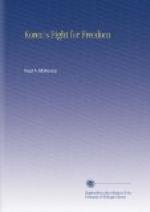The movement was a demonstration, not a riot. On the opening day and afterwards—until the Japanese drove some of the people to fury—there was no violence. The Japanese, scattered all over the country, were uninjured; the Japanese shops were left alone; when the police attacked, elders ordered the people to submit and to offer no resistance. The weak things had set themselves up to confound the strong.
At first, the Japanese authorities were so completely taken by surprise that they did not know what to do. Then the word was passed round that the movement was to be suppressed by relentless severity. And so Japan lost her last chance of winning the people of Korea and of wiping out the accentuated ill-will of centuries.
The first plan of the Japanese was to attack every gathering of people and disperse it, and to arrest every person who took part in the demonstrations or was supposed to have a hand in them. Japanese civilians were armed with clubs and swords and given carte blanche to attack any Korean they suspected of being a demonstrator. They interpreted these instructions freely. Firemen were sent out with poles with the big firemen’s hooks at the end. A single pull with one of these hooks meant death or horrible mutilation for any person they struck.
The police used their swords freely. What I mean by “freely” can best be shown by one incident A little gathering of men started shouting “Mansei” in a street in Seoul. The police came after them, and they vanished. One man—it is not clear whether he called “Mansei” or was an accidental spectator—was pushed in the deep gutter by the roadside as the demonstrators rushed away. As he struggled out the police came up. There was no question of the man resisting or not resisting. He was unarmed and alone. They cut off his ears, cut them off level with his cheek, they slit up his fingers, they hacked his body, and then they left him for dead. He was carried off by some horrified spectators, and died a few hours later. A photograph of his body lies before me as I write. I showed the photograph one evening to two or three men in New York City. Next day I met the men again. “We had nightmare all night long, because of that picture,” they told me.
In Seoul, when the thirty-three leaders were arrested, a demonstration was held in the Park and the Declaration read there. Then the crowd made an orderly demonstration in the streets, waving flags and hats, shouting “Mansei,” parading in front of the Consulates and public buildings, and sending letters to the Consuls informing them of what they had done. There was no violence. The police, mounted and foot, tried to disperse the crowds and made numerous arrests, but the throngs were so dense that they could not scatter them.
Next day was Sunday. Here the strong Christian influences stopped demonstrations, for the Korean Christians observe the Sunday strictly. This gave the Japanese authorities time to gather their forces. Numerous arrests were made that day, not only in Seoul but all over the country. On Monday there was the funeral of the ex-Emperor. The people were quiet then. It was noticed that the school children were entirely absent from their places along the line of march. They had struck.




